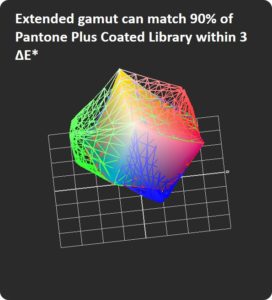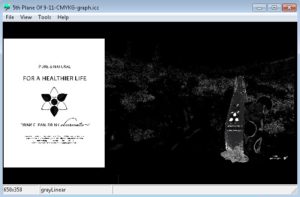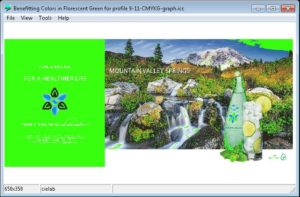Color-critical print jobs. You’re familiar with them and have undoubtedly received your fair share. They come in all shapes and sizes – from brand logos and corporate colors to jobs that require precise color matching from page-to-page and run-to-run.
However, history shows that matching true spot colors hasn’t always been easy or affordable.
Coming to grips with industry-wide color challenges
Designers, print buyers and printers alike have historically been faced with a few basic choices:
- Find an offset printer that can allocate a printing tower or two for the necessary spot colors. If the job also involves full color photos, a five or six-color press may be needed. This route obviously isn’t ideal for small quantities and limited budgets.
- Select a four color printing process, capable of reproducing roughly only 55% of the Pantone library, and live with the results.
Both scenarios described above have their own flaws. Choose either precise accuracy at the expense of greater costs…or choose lower accuracy but with the advantages of personalization and on-demand flexibility.
Thankfully, the barriers preventing accurate, affordable and flexible color reproduction are slowly coming down.
Accurately hitting spot color with digital printing and Extended Gamut
 New advancements are making it possible for digital print technologies to achieve a vastly greater number of spot colors. Extended Gamut is one such advancement, doing just as its name indicates, by introducing additional base inks into the printing process.
New advancements are making it possible for digital print technologies to achieve a vastly greater number of spot colors. Extended Gamut is one such advancement, doing just as its name indicates, by introducing additional base inks into the printing process.
In the past, a digital printer needing to recreate a tone of orange would do so by combining yellow and magenta inks. This would often result in a very muddied and inaccurate orange. With Extended Gamut, orange ink can simply be used, resulting in a more pure, accurate representation.
With the Xerox iGen 5 Press, orange, green or blue (chosen to match a greater number of Fortune-500 corporate colors) can be loaded into its optional fifth color unit. Perhaps most importantly, 90% of the Pantone Plus Coated library can be matched within 3 Delta E-1976 (dE) thanks to Extended Gamut.
4 or 5 color process printing: How do I know when to use the 5th color?
With the Xerox iGen 5 Press front-ended by Xerox FreeFlow Print Server, it’s very easy to determine if a spot color can be accurately achieved using a simple CMYK four-color process printing recipe. Similarly, it’s easy to see how much of a benefit the 5th color can add.
**Editor’s Note: See the demo LIVE on Periscope**
By selecting the corresponding four and five-color profiles, press operators can quickly see at-a-glance a variety of useful information related to all spot colors. This includes the Lab values of each, a designation indicating whether they are ‘out of gamut’, and the accuracy (measured in dE) for reproducing a given spot color.
In the example below, we are attempting to achieve Pantone 3405C. The question is whether to use a four or five-color printing process. As you can see, the four-color process will have a very difficult time hitting this color with a dE of over 23 (shown by the column on the far-right). Meanwhile, using a five-color process with green as the 5th color will reduce that dE to 3.46 – a very acceptable result and a drastic difference.


My job has multiple spot colors. Can I enable 5 color printing for certain spots, and disable it for others?
Yes! Fortunately, using five-color printing is not an all-or-nothing proposition with FreeFlow Print Server. If your job contains several spot colors, you can selectively choose which spot colors to produce using the 5th color, and which to handle with basic CMYK.
This is important, as your consumable costs will not be driven up using a 5th color in areas that will not provide a discernably benefit.
Is there a way to automate 5 color vs. 4 color decisions?
While operators can manually compare each spot color in their job and the associated accuracy that can be achieved using four and five colors, this can also be very time consuming. To help streamline this process, FreeFlow Print Server comes equipped with “Xerox Intelligent Spot Color Technology” capability.
The operator simply specifies a dE accuracy window and FreeFlow Print Server intelligently and automatically applies the 5th color to spots where it is required to meet the defined accuracy window. All other spots will be rendered in 4 colors.
**Editor’s Note: See the demo LIVE on Periscope**
How can I quantify the value and effect of using a 5th color for a specific image?
What if your operator wants a visual way to represent where the 5th color is being used and how much of an impact it’s making?
FreeFlow Print Server’s Gamut Checker, available in a future release, can provide this information. By inputting a PDF and selecting two different output profiles, the user will be presented with a series of representations to help convey where the 5th color is being used and the associated benefit:
- The first is a visual comparison of the original image compared with the 4-color and 5-color renderings of the image. This is helpful for discerning immediate variations between target colors and four/five color simulations.
 The next representation focuses on the 5th plane, with tints of white representing where the Extended Gamut colorant will be used and to what extent. The whiter the representation, the more 5th color being applied in those specific pixels. This gives great perspective on where the 5th color is used and an estimation of its overall coverage.
The next representation focuses on the 5th plane, with tints of white representing where the Extended Gamut colorant will be used and to what extent. The whiter the representation, the more 5th color being applied in those specific pixels. This gives great perspective on where the 5th color is used and an estimation of its overall coverage.
- In the third view, florescent green showcases all areas of an image where the 5th color provided some level of benefit to the document. You may notice non-spot colors receiving an improvement as well. This is because 5-color profiles can achieve darker darks than 4-color profiles.

- Finally, an additional representation shows areas, represented in white, where use of a 5th color provided a greater than 3 dE improvement.
Together, these representations and information are very valuable in helping an operator determine if they are truly getting a ‘bang for their buck’ from the 5th color, or whether they can make due by using only CMYK.
Have questions?
Color is one of the most critical, yet challenging, parts of the printing process to master. Fortunately, new advancements in technology are making it easier to control. If you have questions or comments, please share and we’re happy to help!



